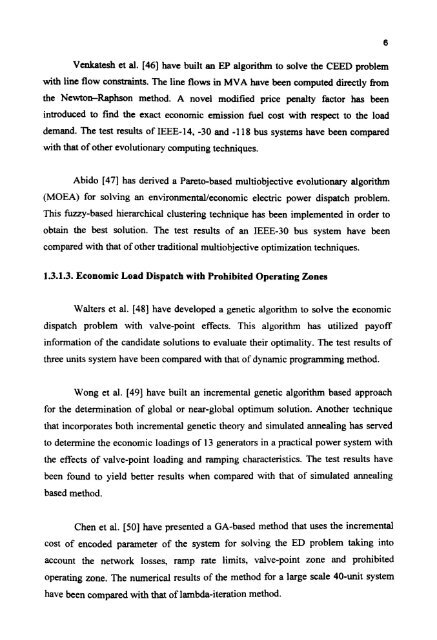performance evaluation of swarm intelligence based power system ...
performance evaluation of swarm intelligence based power system ...
performance evaluation of swarm intelligence based power system ...
Create successful ePaper yourself
Turn your PDF publications into a flip-book with our unique Google optimized e-Paper software.
Venkatesh et al. [46] have built an EP algorithm to solve the CEED pmblemwith line flow constraints. The line flows in MVA have been computed directly fromthe Newto=Raphson method. A novel modified price penalty factor has beenintroduced to find the exact economic emission fuel cost with respect to the loaddemand. The test results <strong>of</strong> IEEE-14, -30 and -1 18 bus <strong>system</strong>s have been comparedwith that <strong>of</strong> other evolutionary computing techniques.Abido [47] has derived a Pareto-<strong>based</strong> multiobjective evolutionary algorithm(MOEA) for solving an environmental/economic electric <strong>power</strong> dispatch pmblem.This fuzzy-<strong>based</strong> hierarchical clustering technique has been implemented in order toobtain the best solution. The test results <strong>of</strong> an IEEE-30 bus <strong>system</strong> have beencompared with that <strong>of</strong> other traditional multiobjective optimization techniques.1.3.1.3. Economic Load Dispatch with Prohibited Operating ZonesWalters et al. 1481 have developed a genetic algorithm to solve the economicdispatch problem with valve-point effects. This algorithm has utilized pay<strong>of</strong>finformation <strong>of</strong> the candidate solutions to evaluate their optimality. The test results <strong>of</strong>three units <strong>system</strong> have been compared with that <strong>of</strong> dynamic programming method.Wong et al. [49] have built an incremental genetic algorithm <strong>based</strong> approachfor the determination <strong>of</strong> global or near-global optimum solution. Another techniquethat incorporates both incremental genetic theory and simulated annealing has servedto determine the economic loadings <strong>of</strong> 13 generators in a practical <strong>power</strong> <strong>system</strong> withthe effects <strong>of</strong> valve-point loading and ramping characteristics. The test results havebeen found to yield better results when compared with that <strong>of</strong> simulated annealing<strong>based</strong> method.Chen et al. [50] have presented a GA-<strong>based</strong> method that uses the incrementalcost <strong>of</strong> encoded parameter <strong>of</strong> the <strong>system</strong> for solving the ED problem taking intoaccount the network losses, ramp rate limits, valve-point zone and prohibitedoperating zone. The numerical results <strong>of</strong> the method for a large scale 40-unit <strong>system</strong>have been compared with that <strong>of</strong> lambda-iteration method.
















